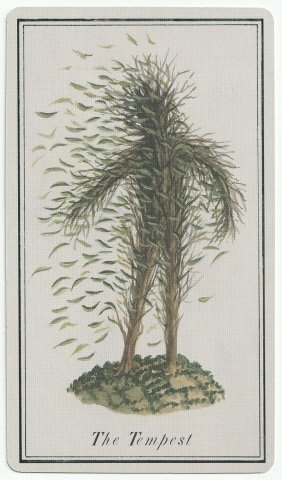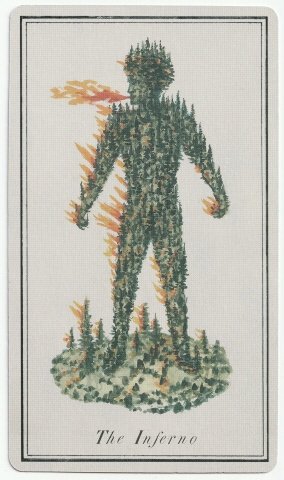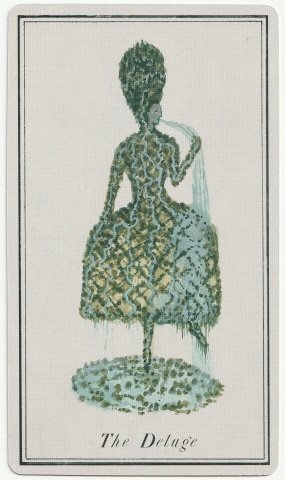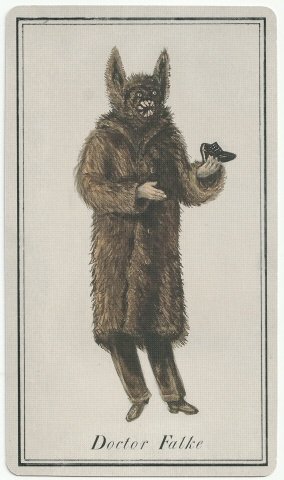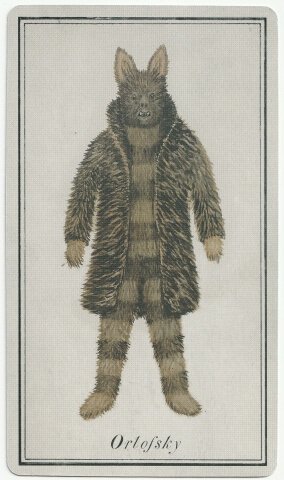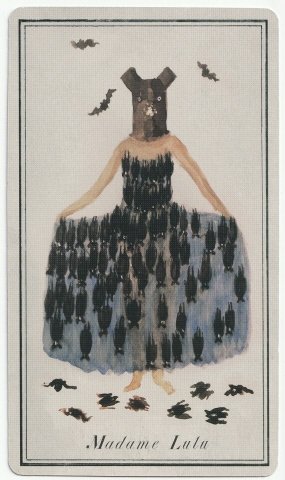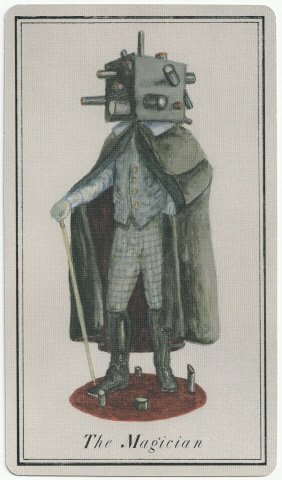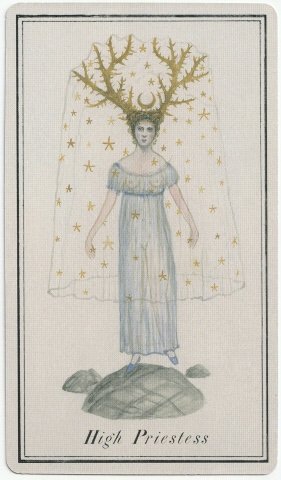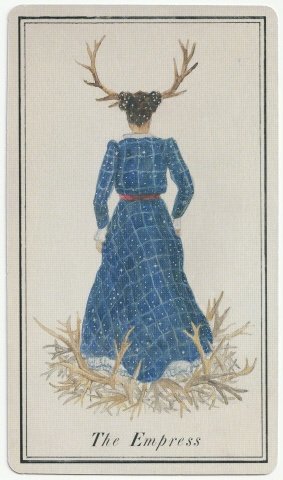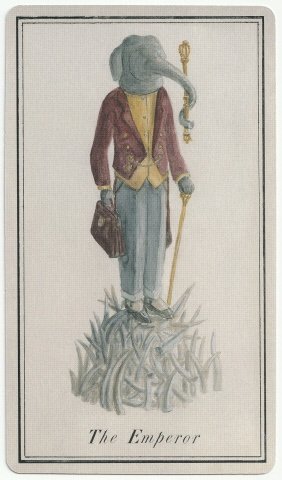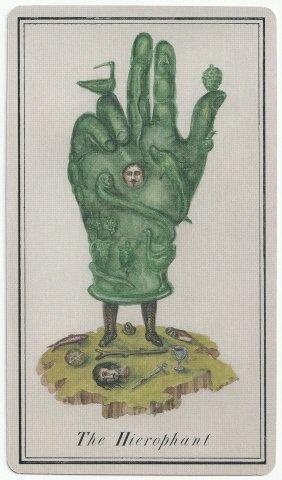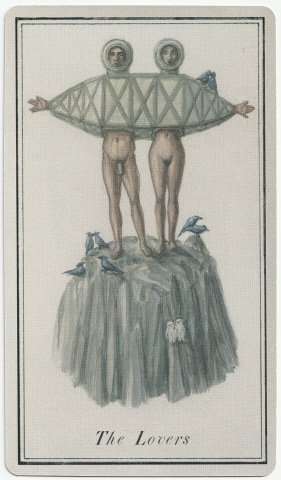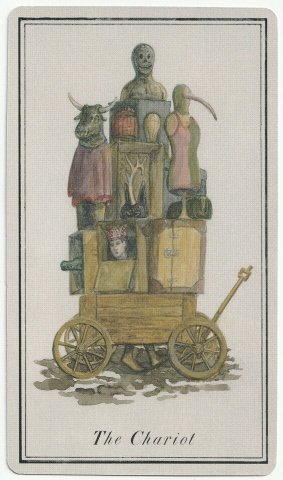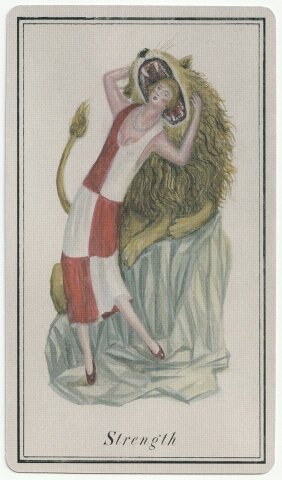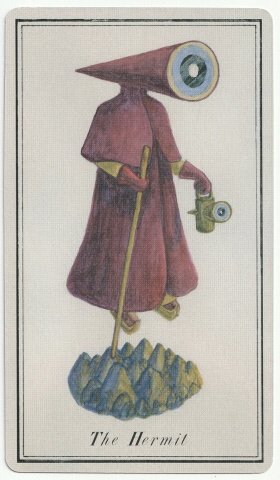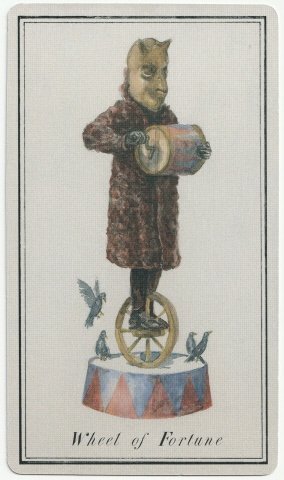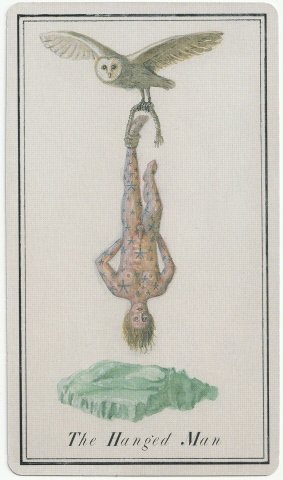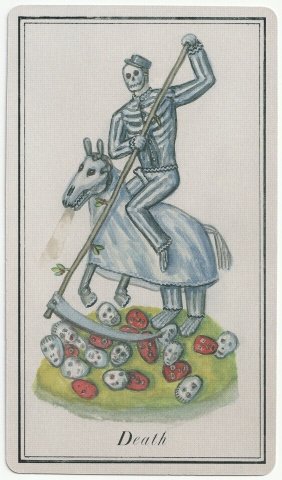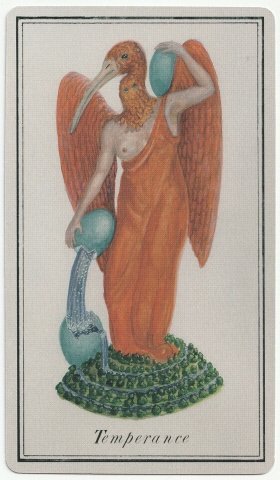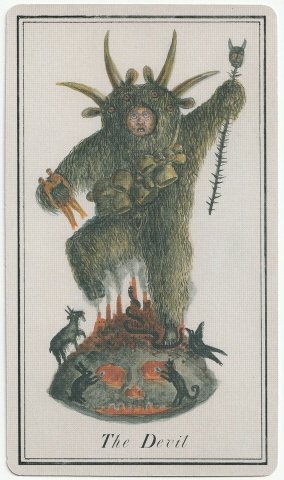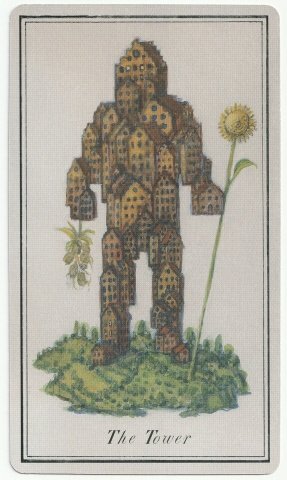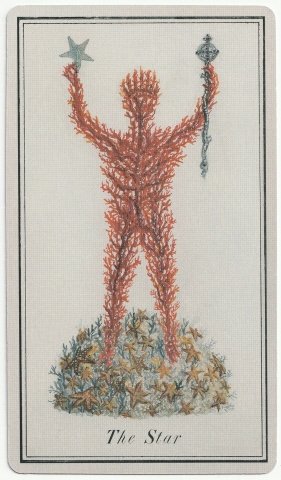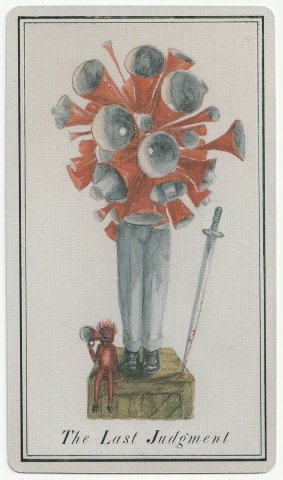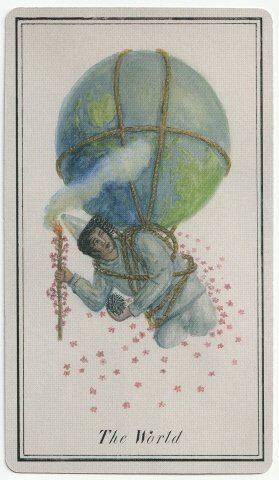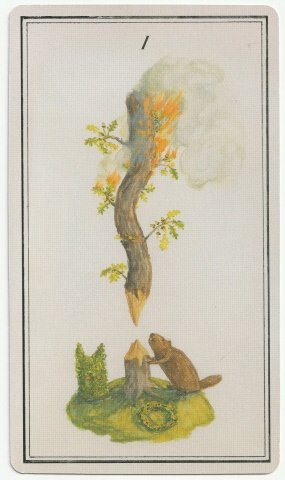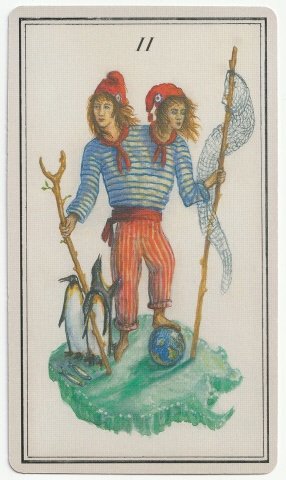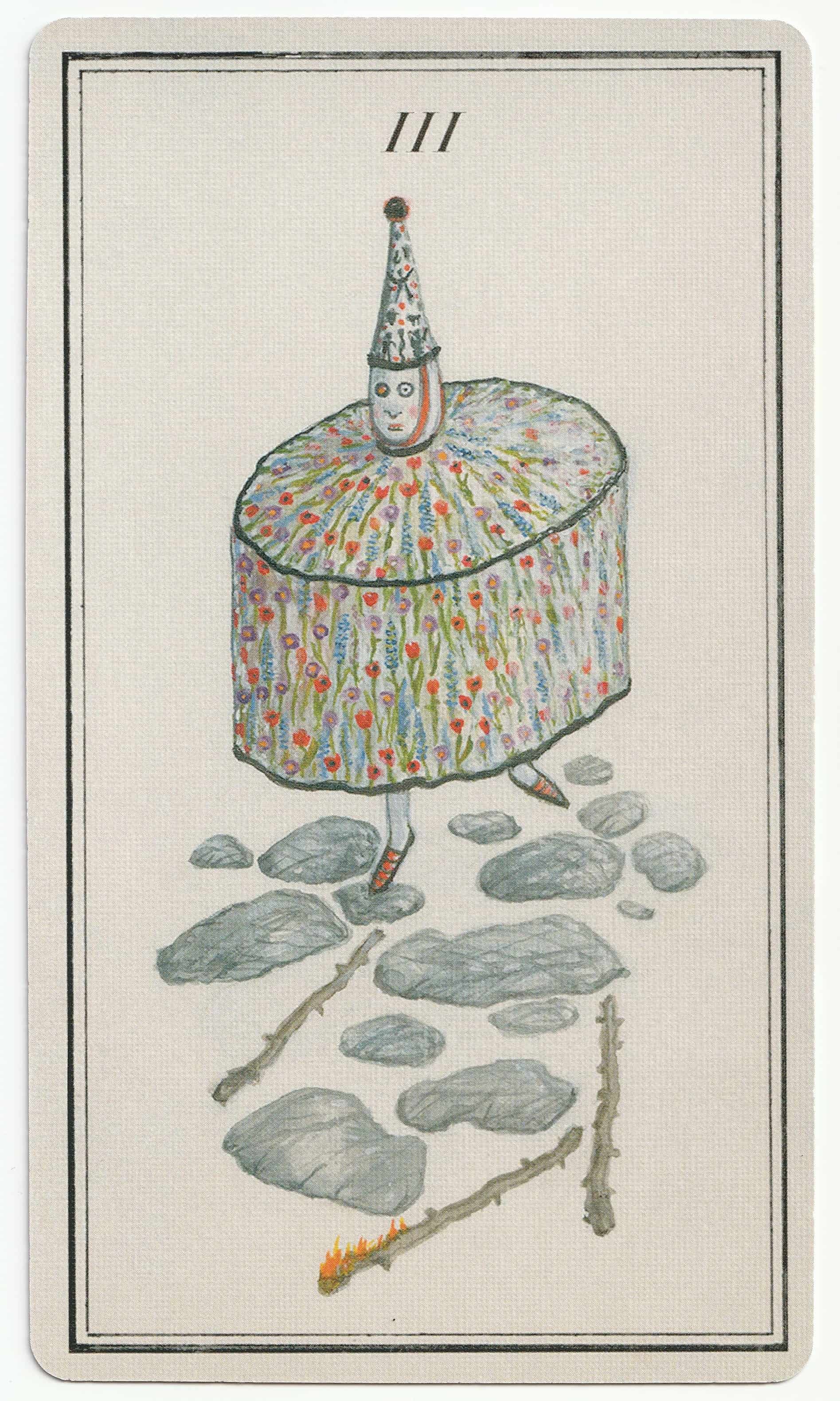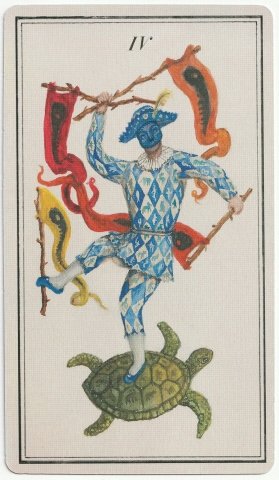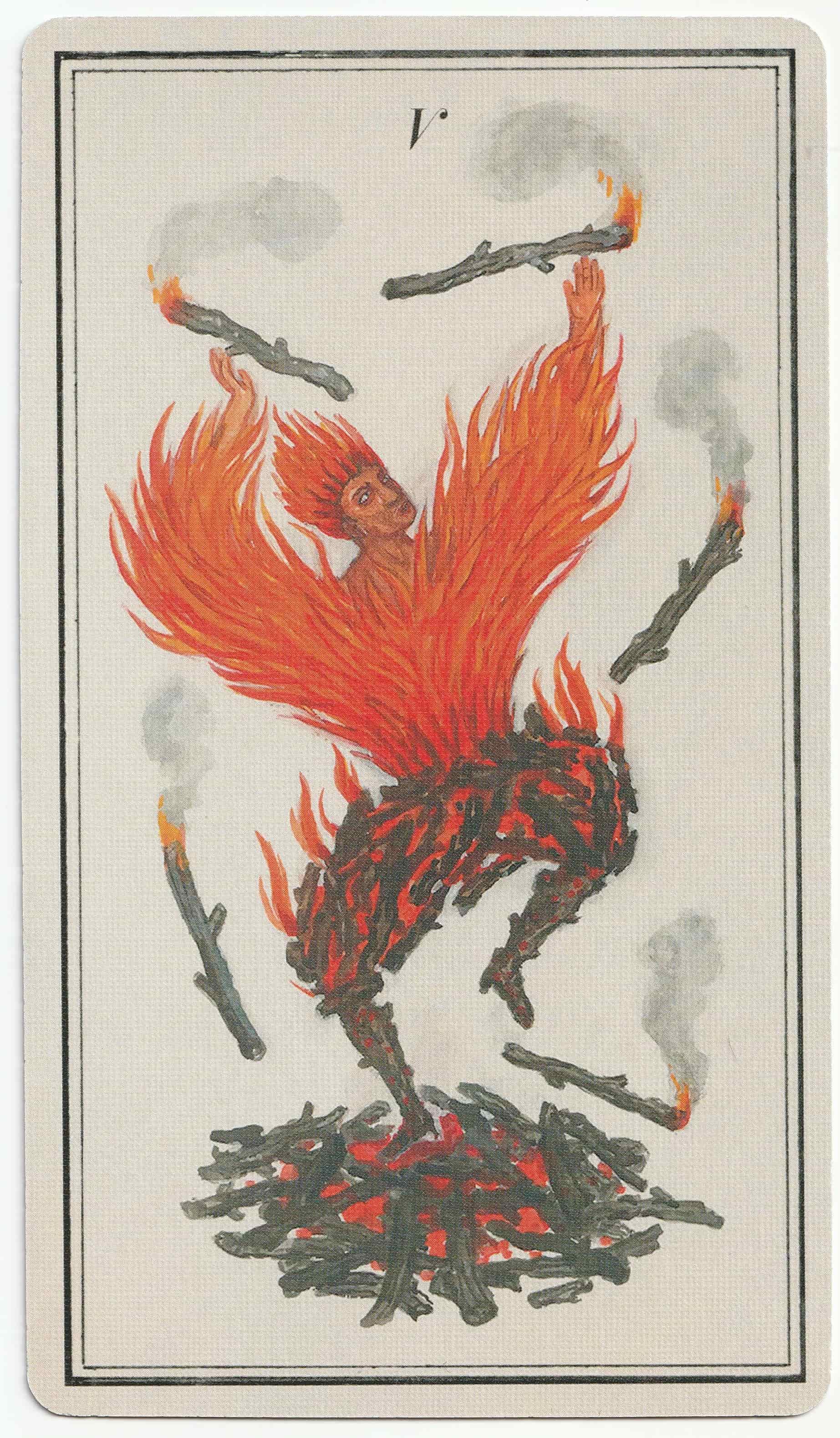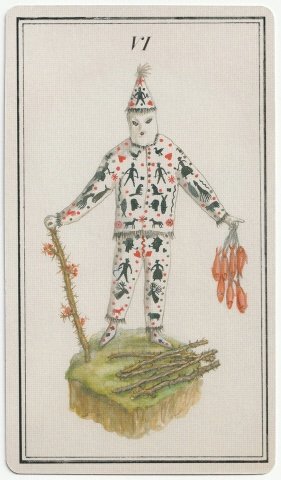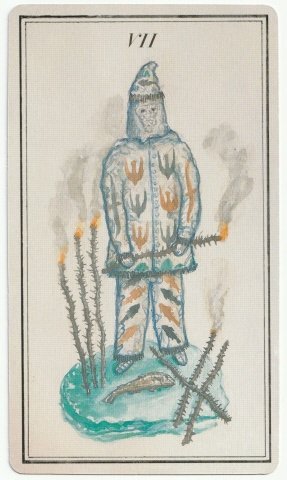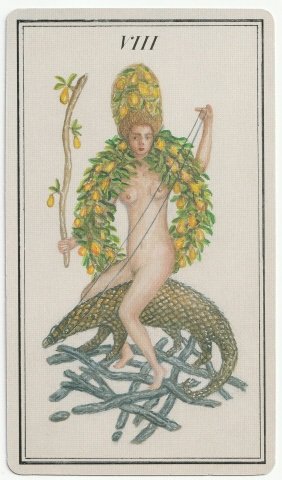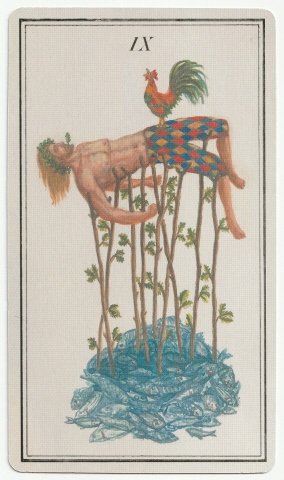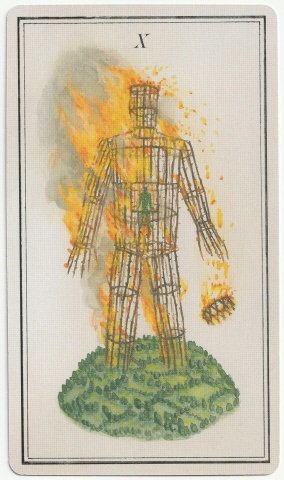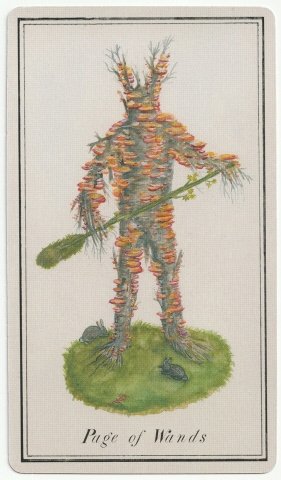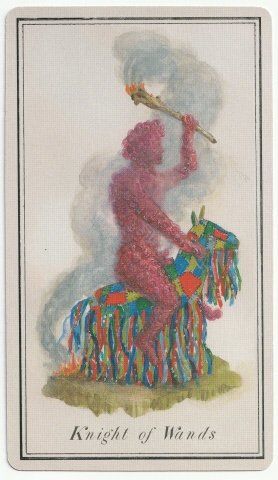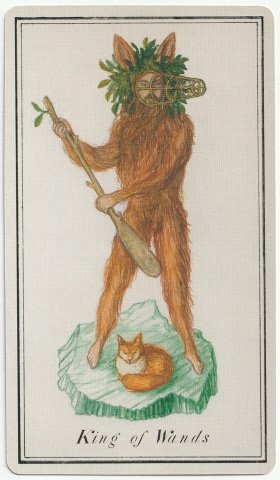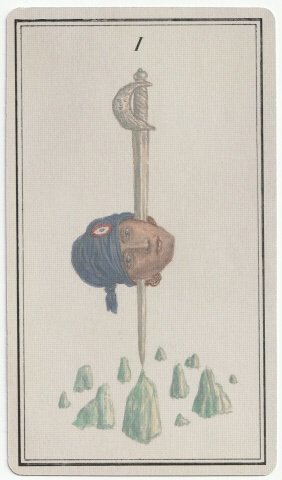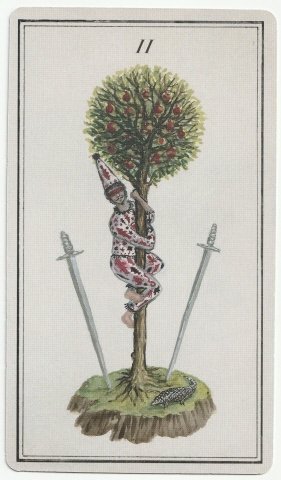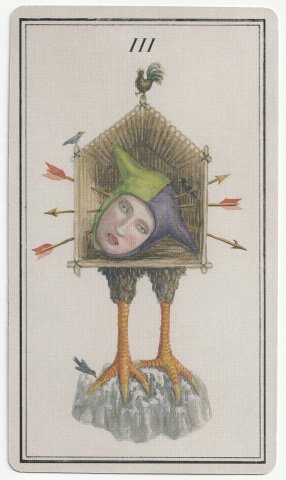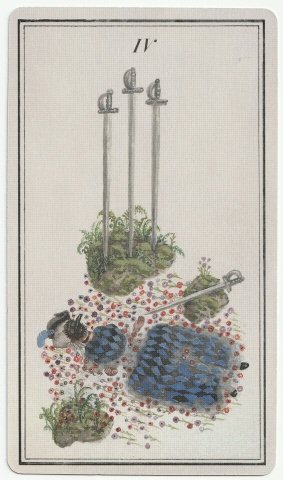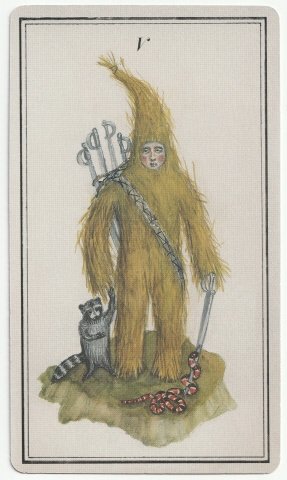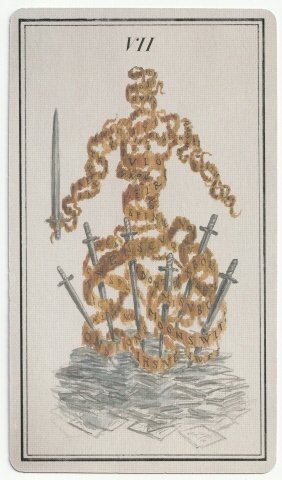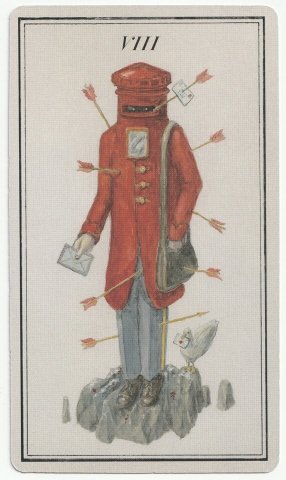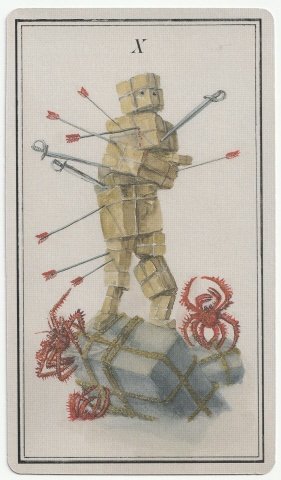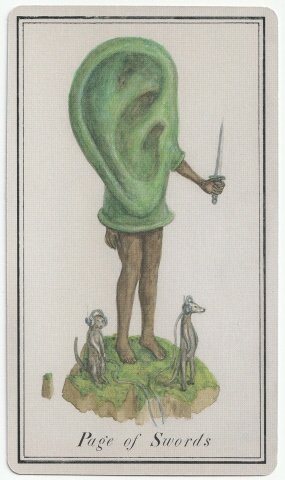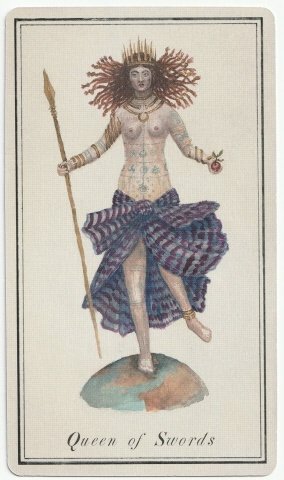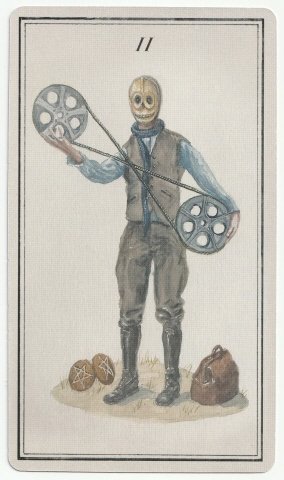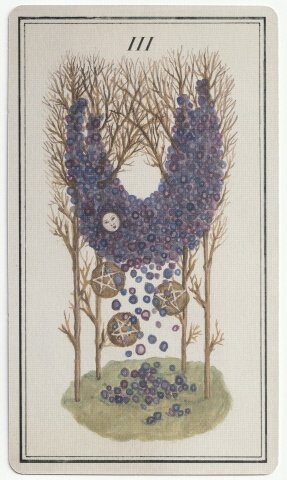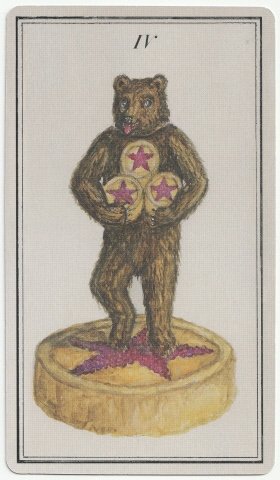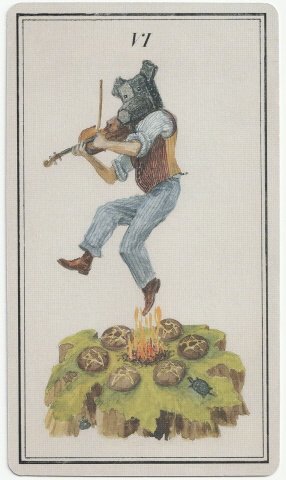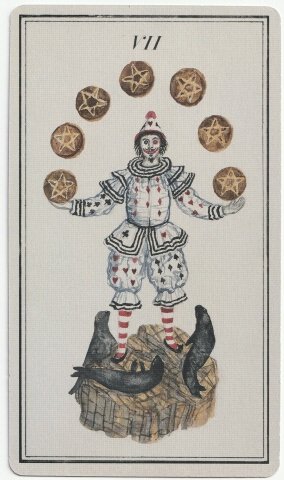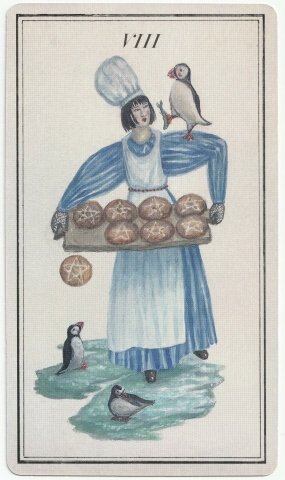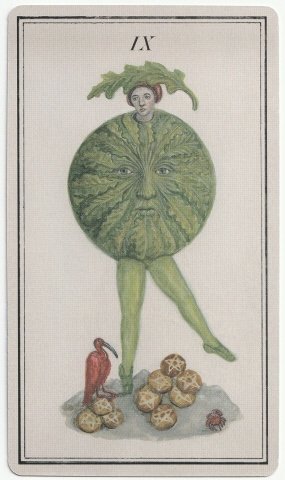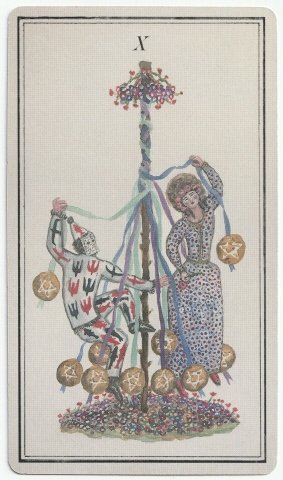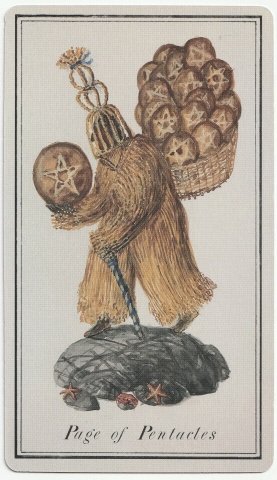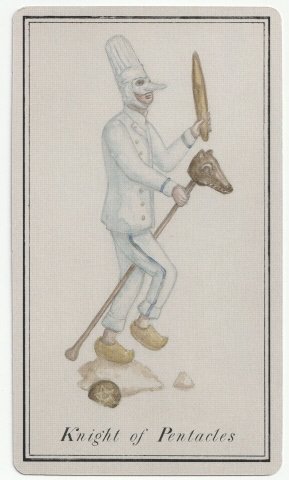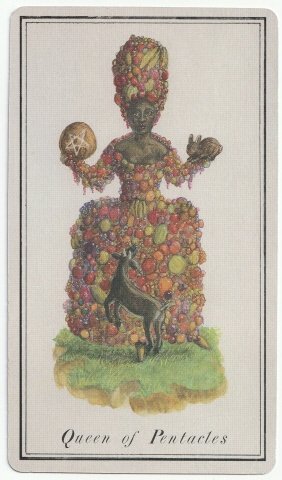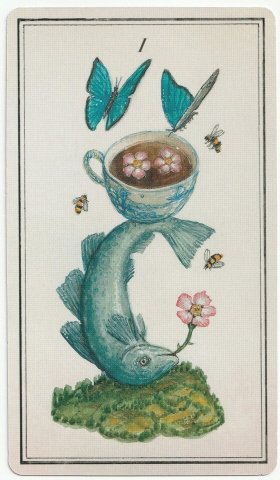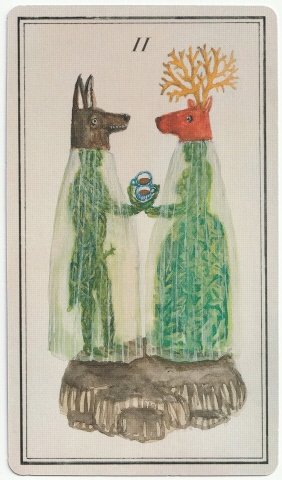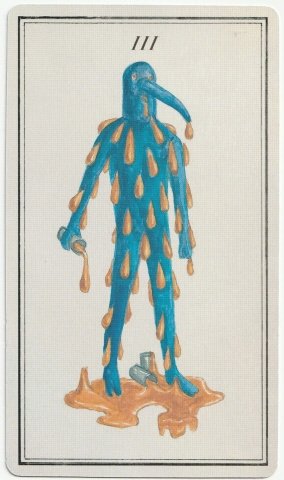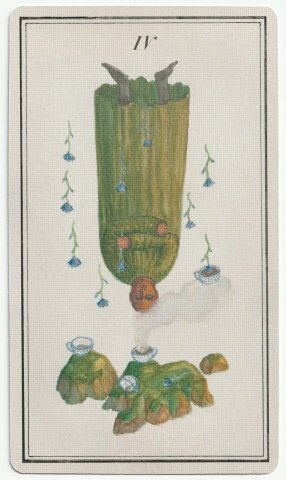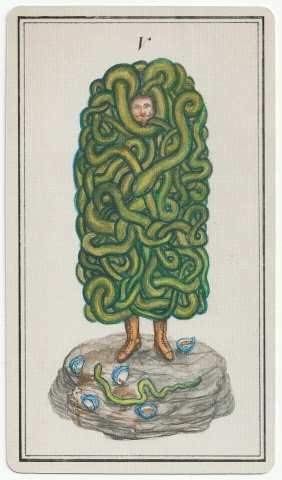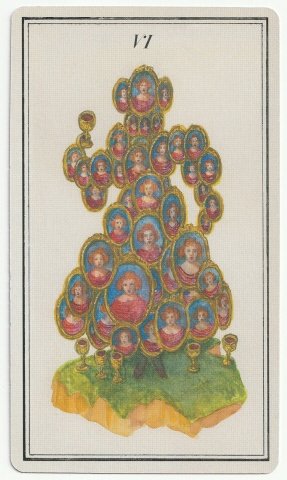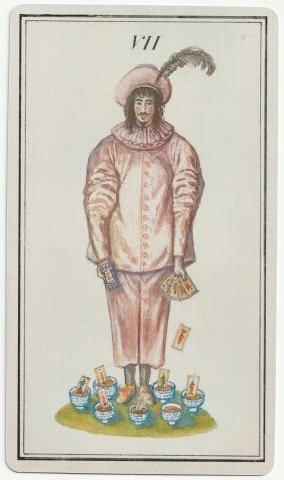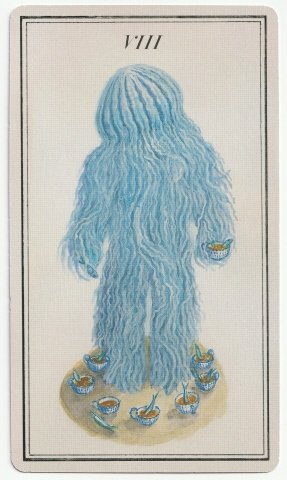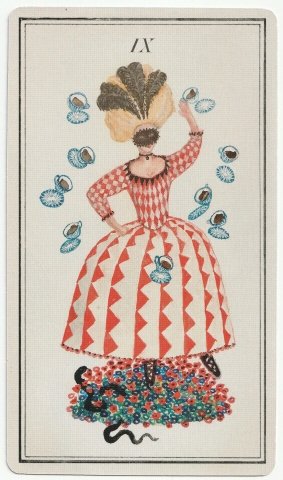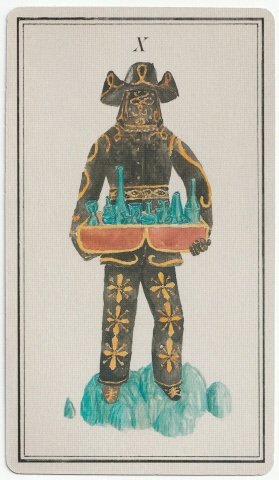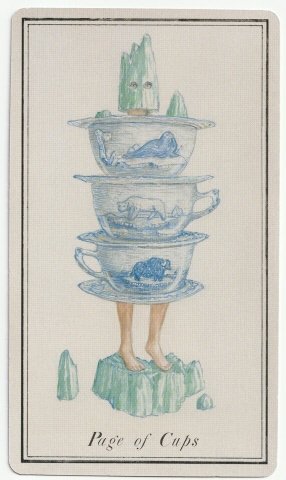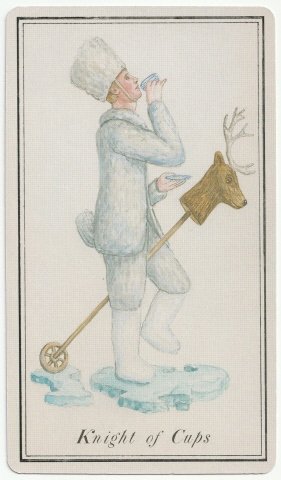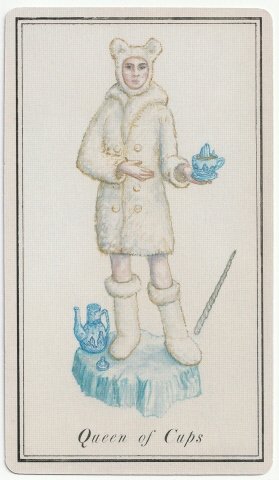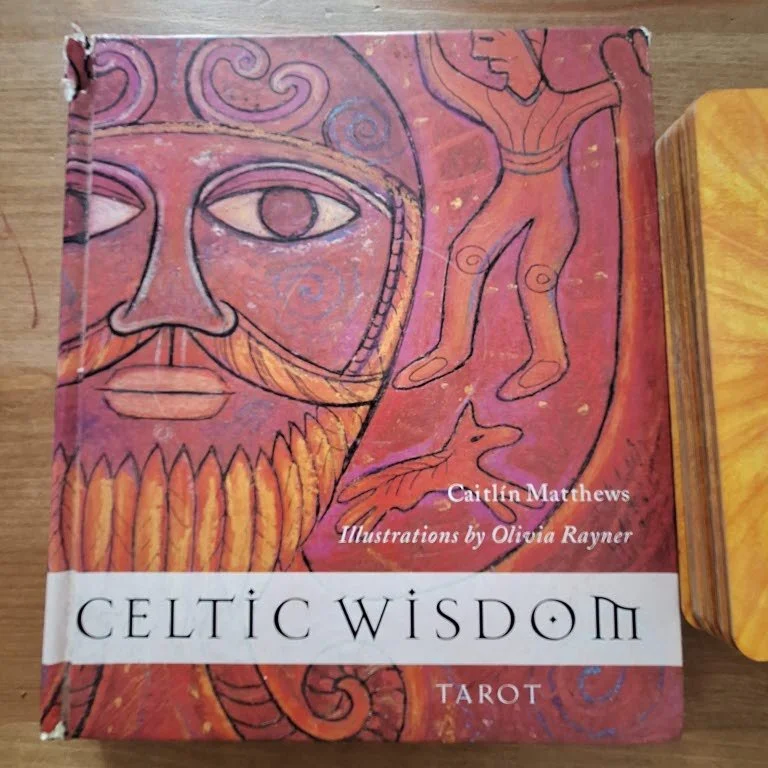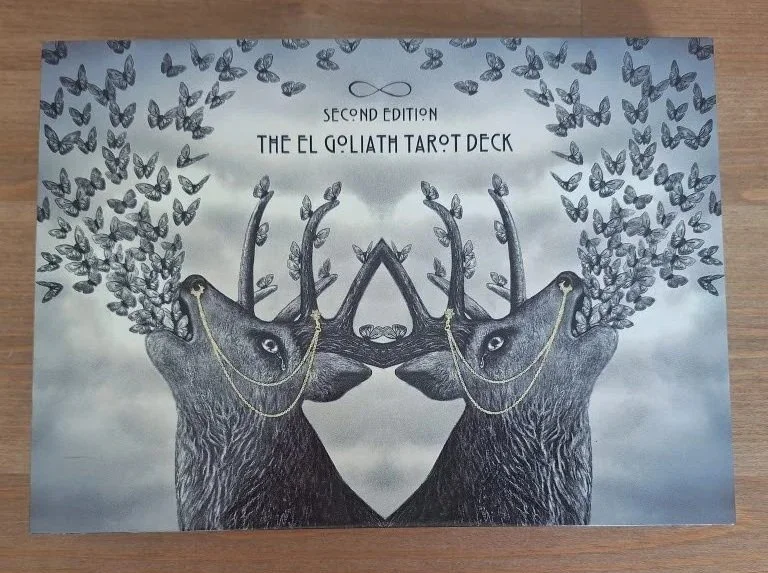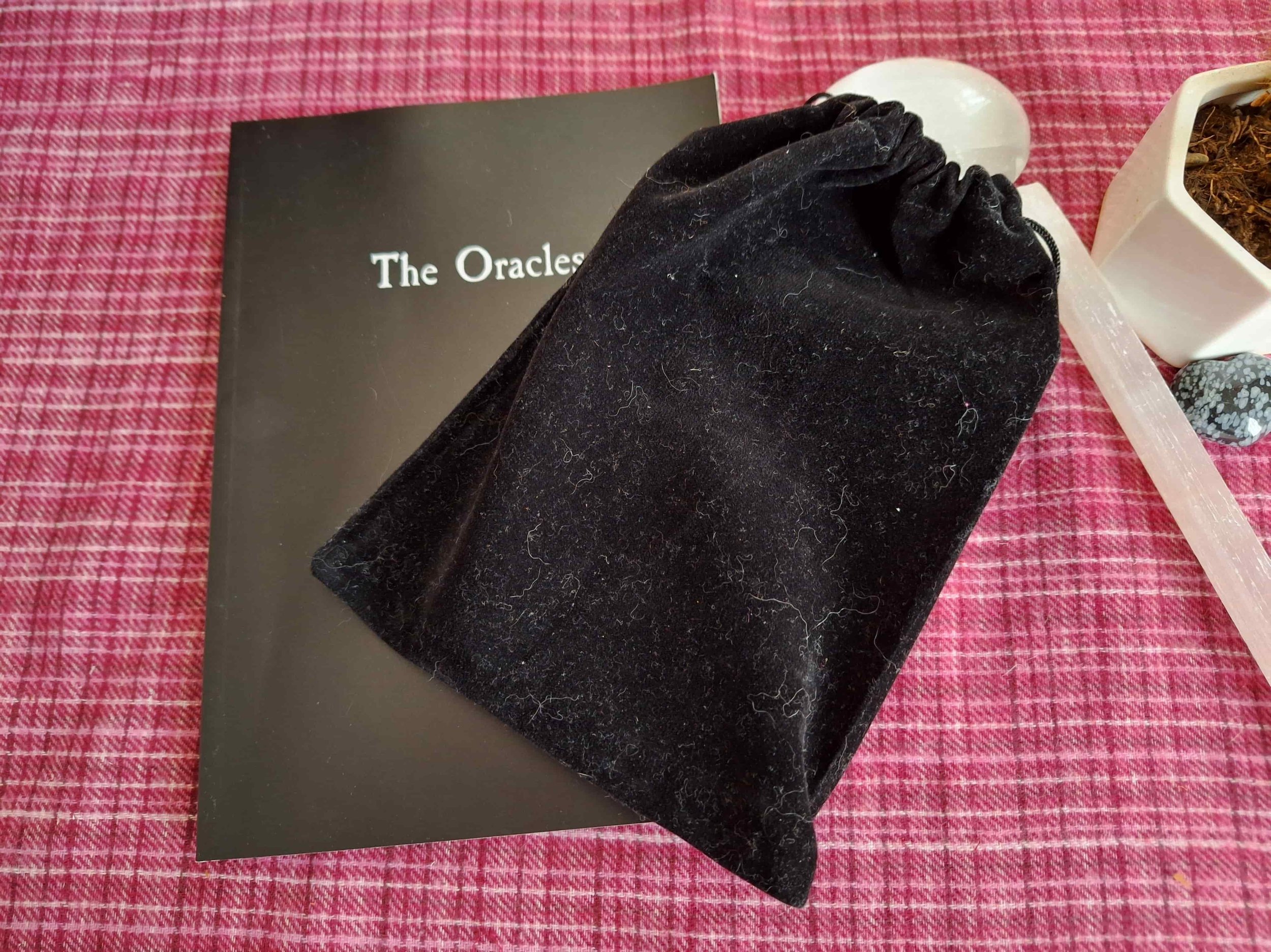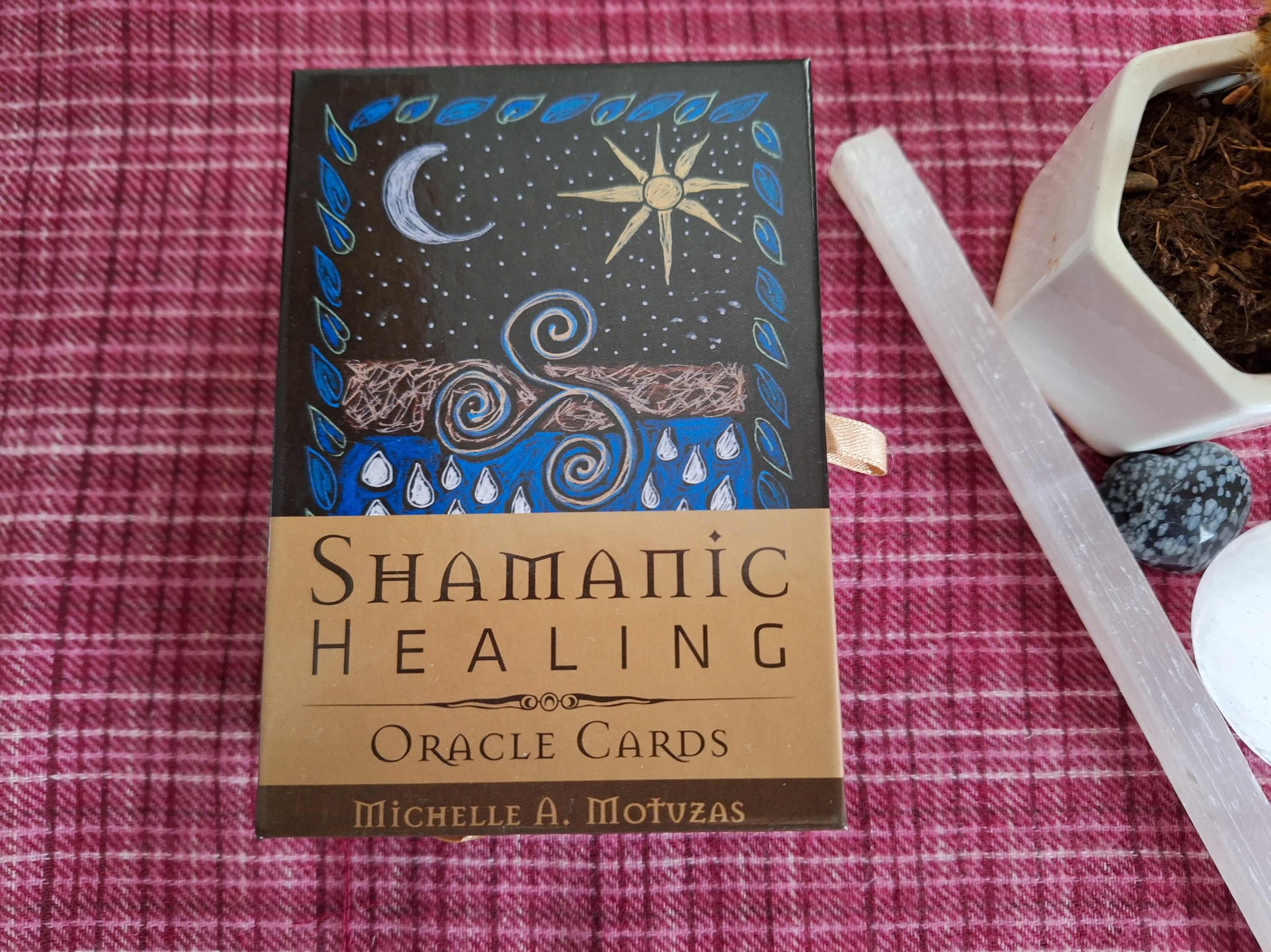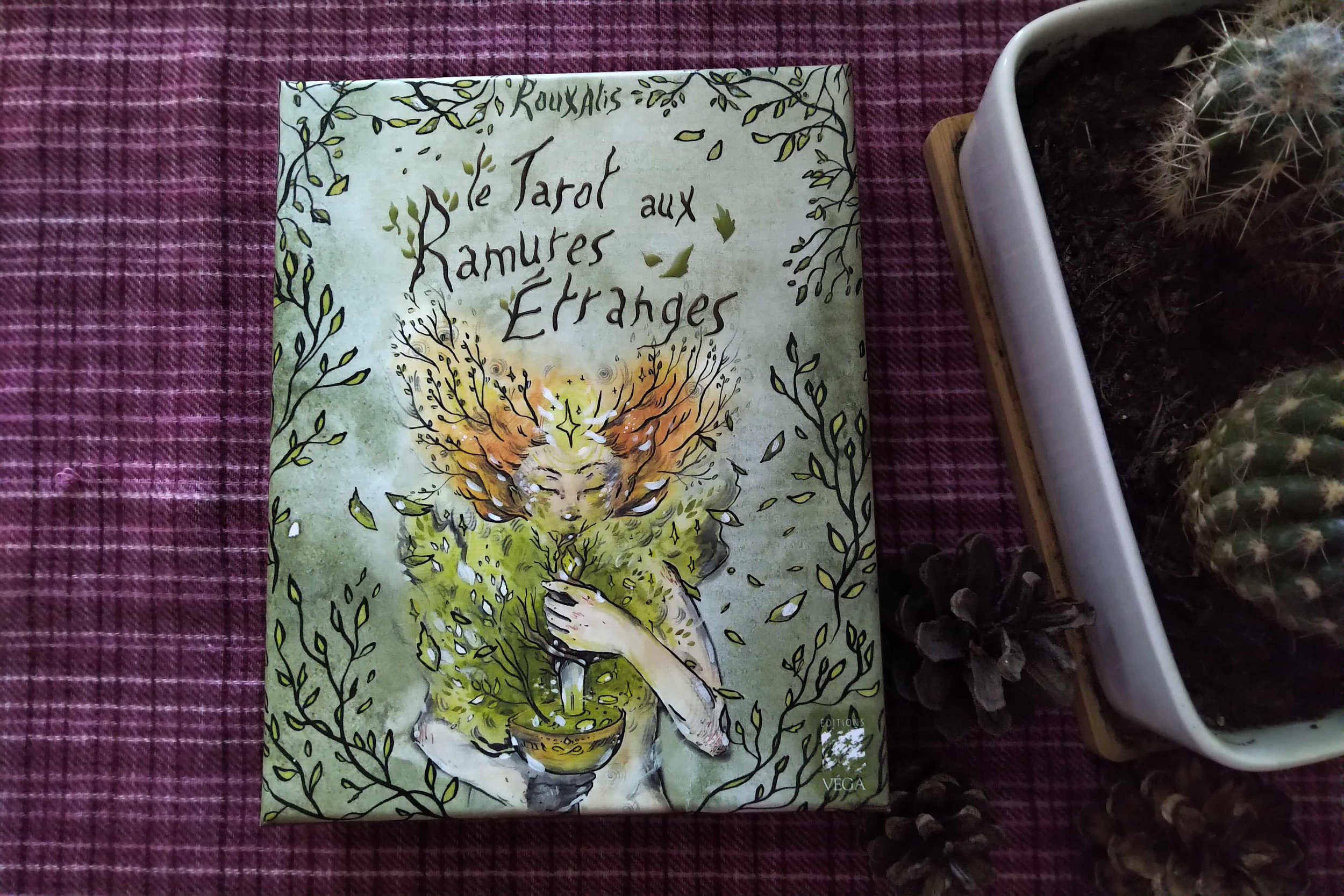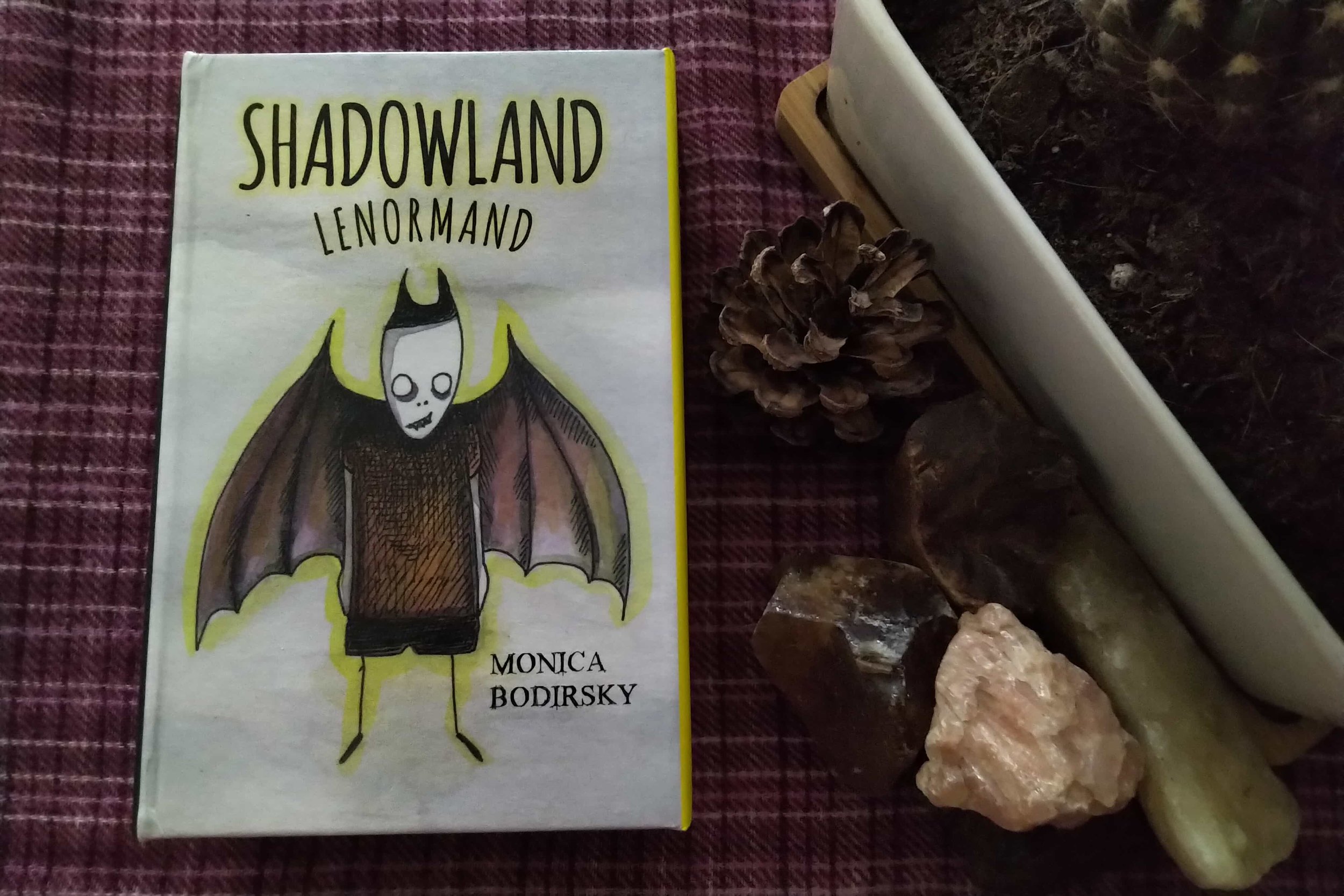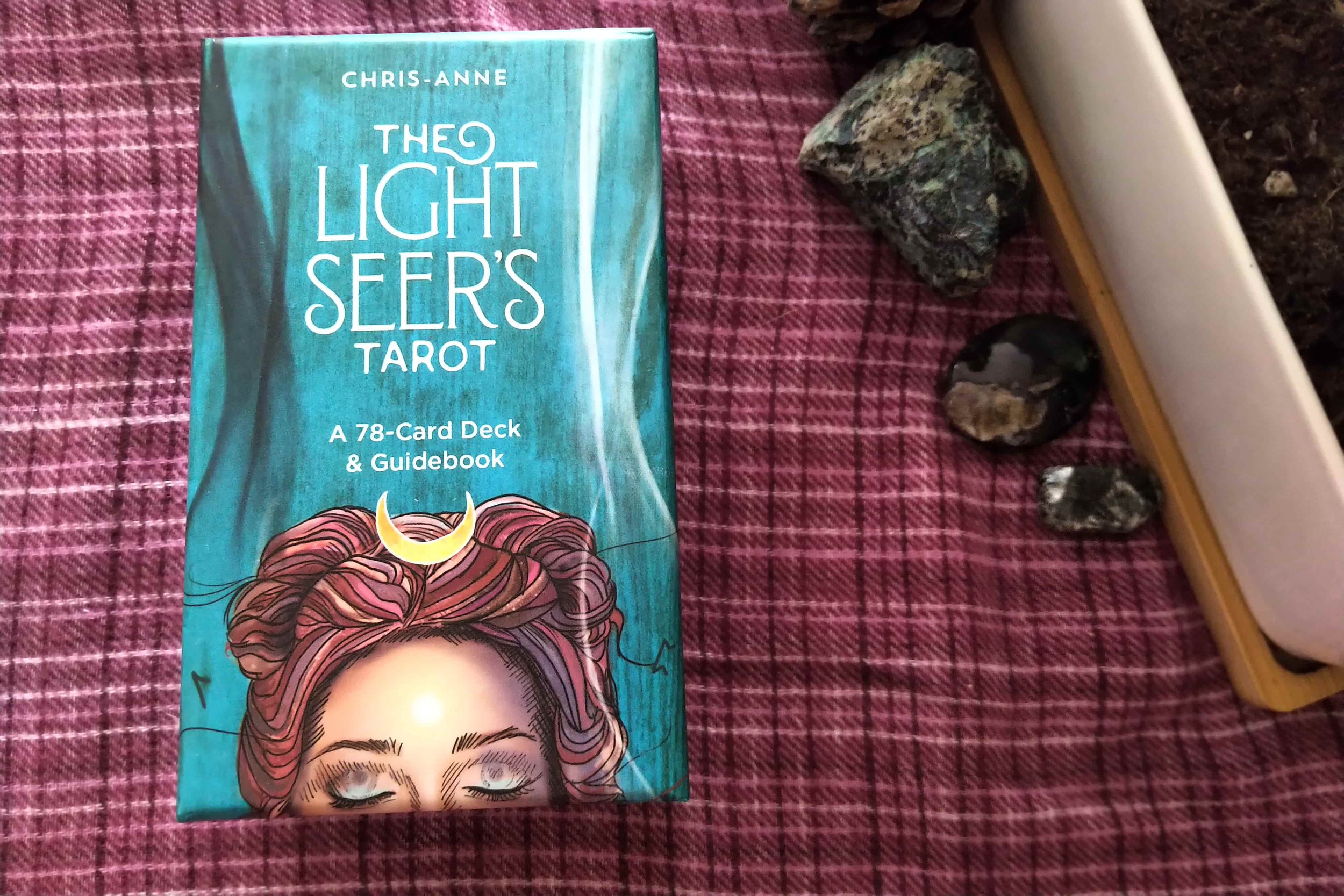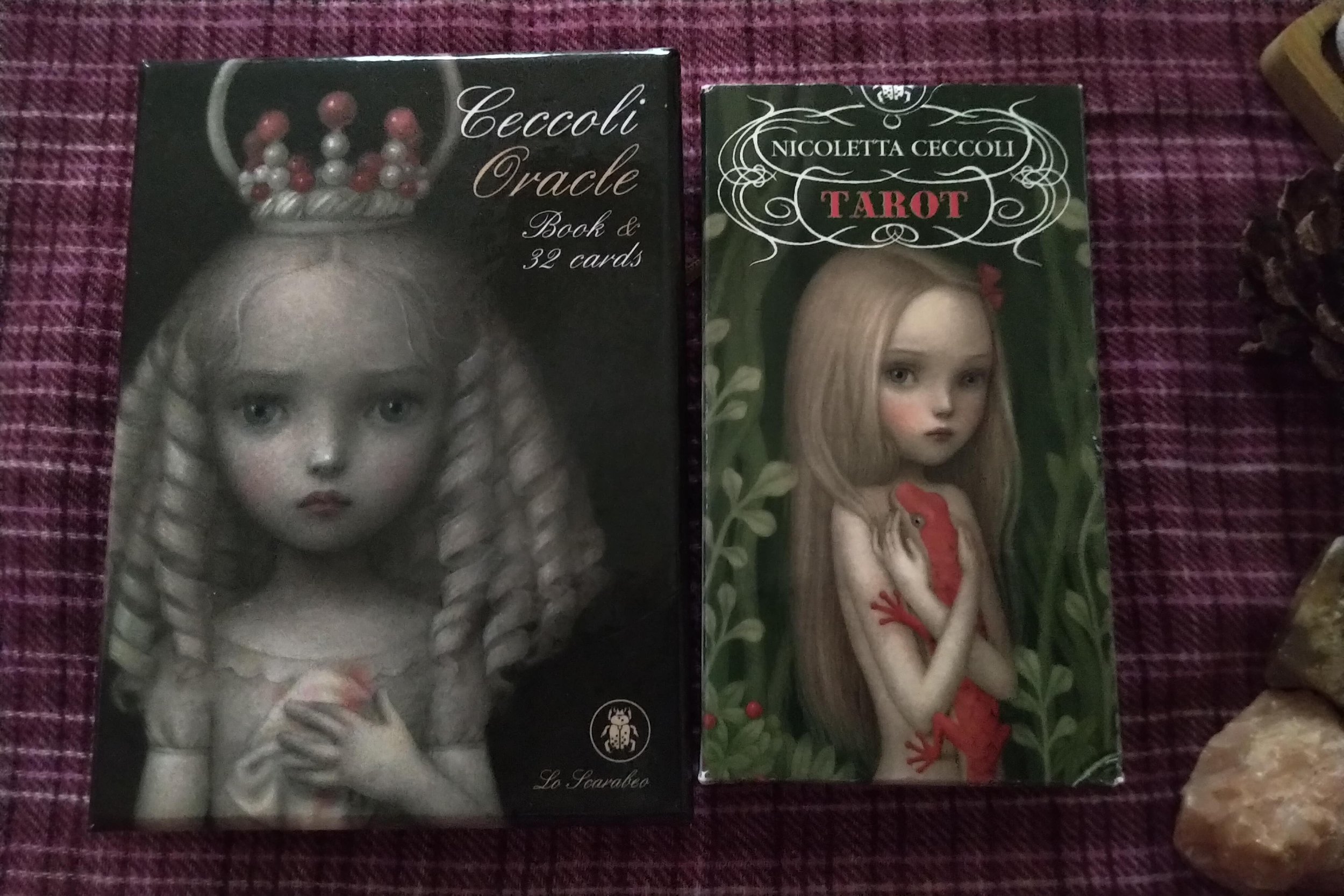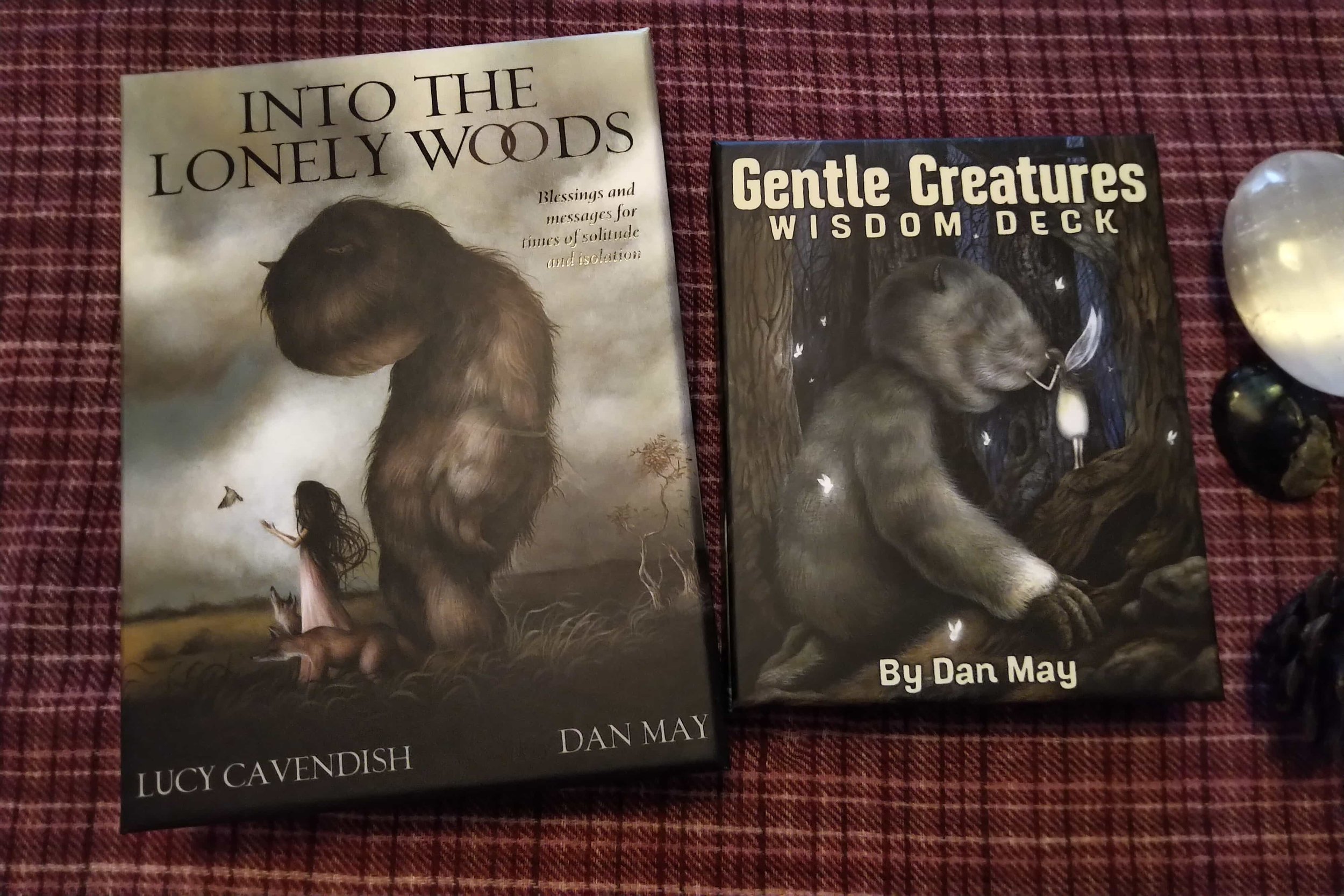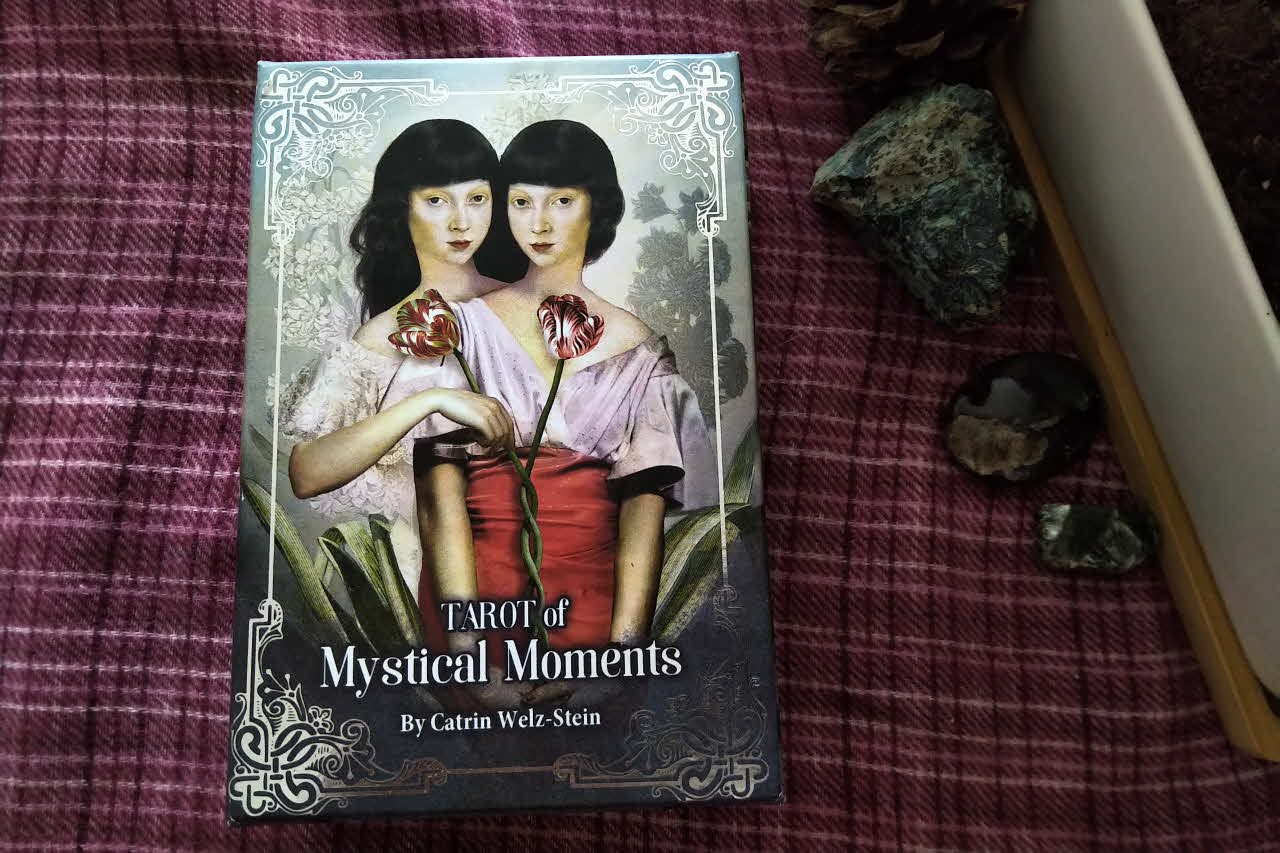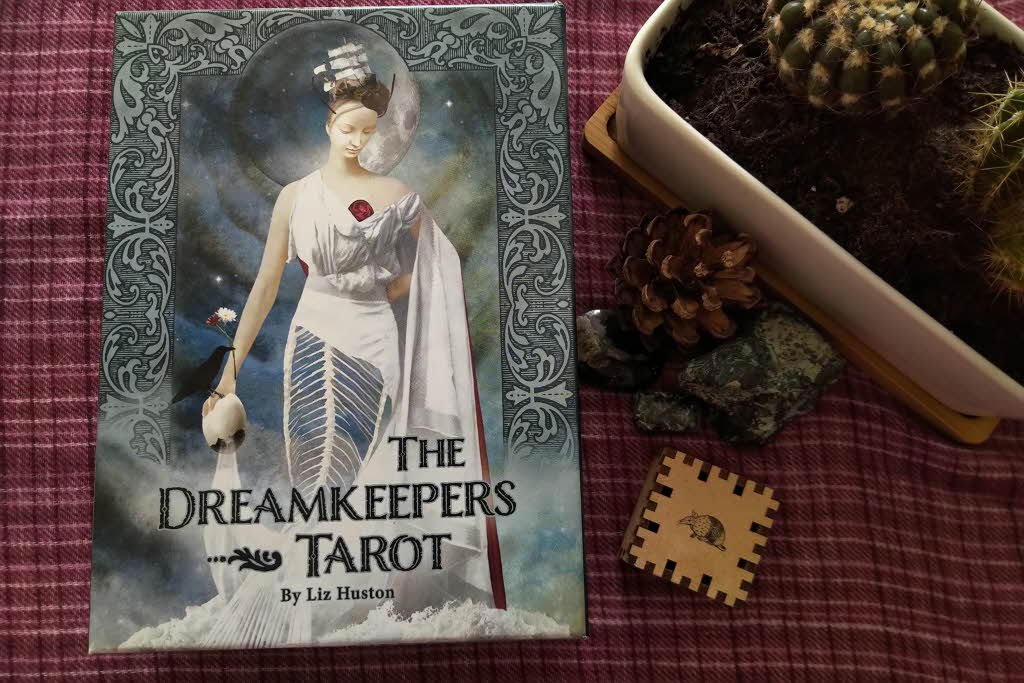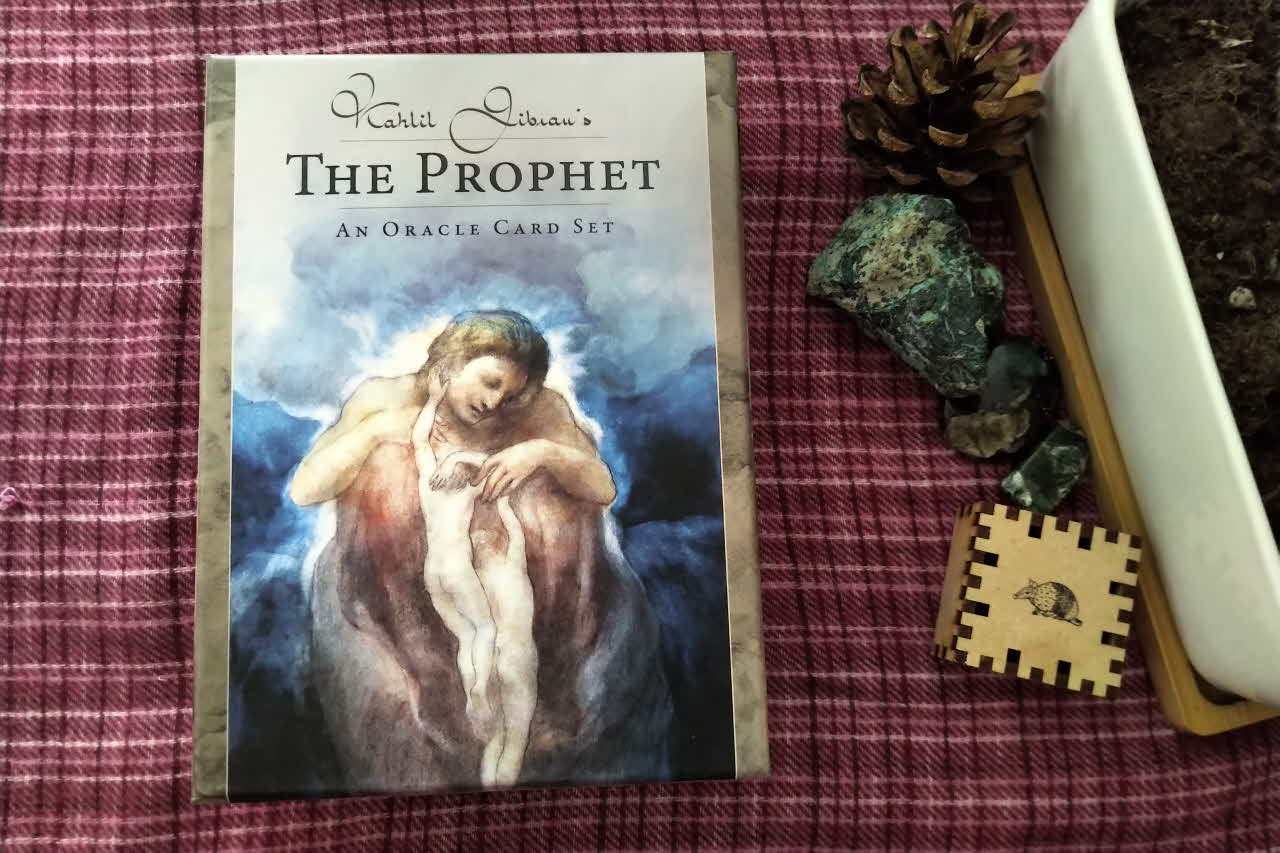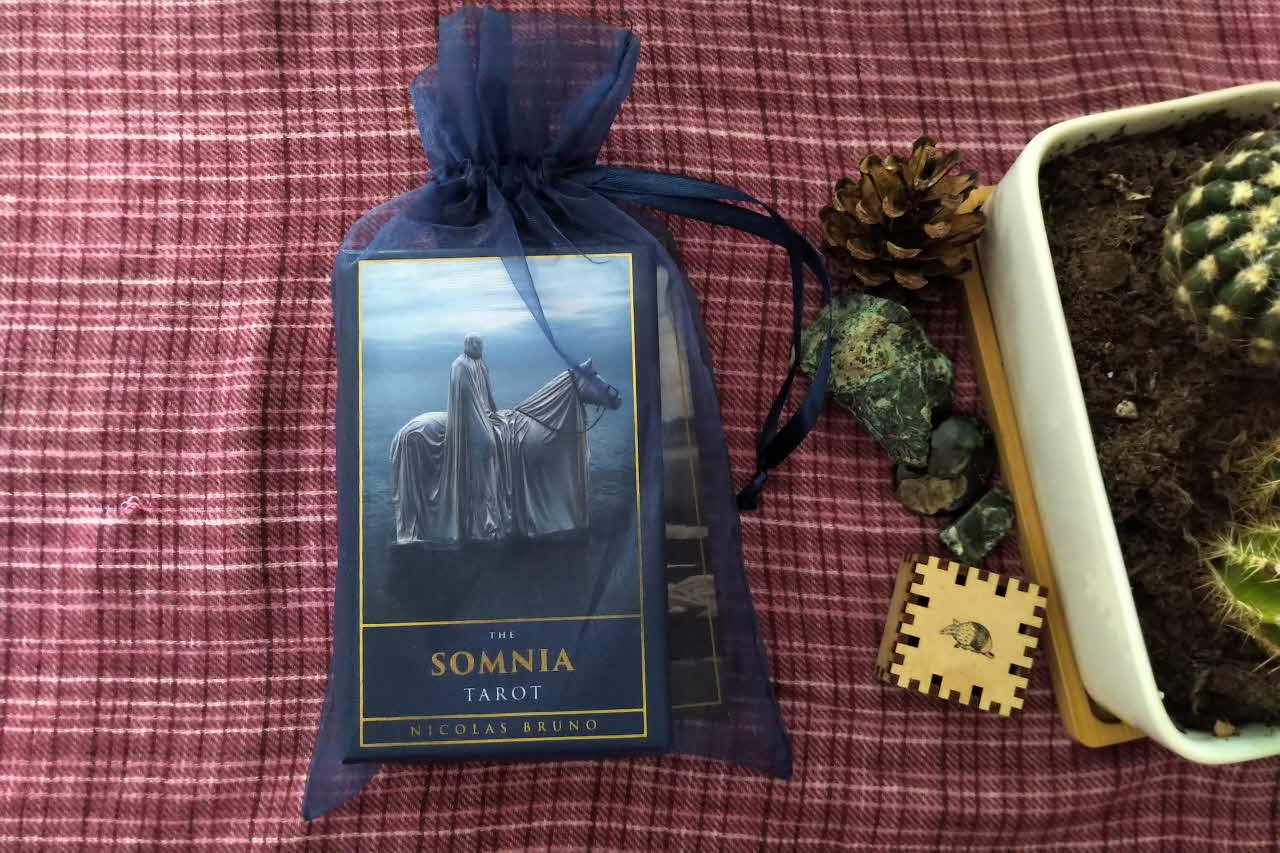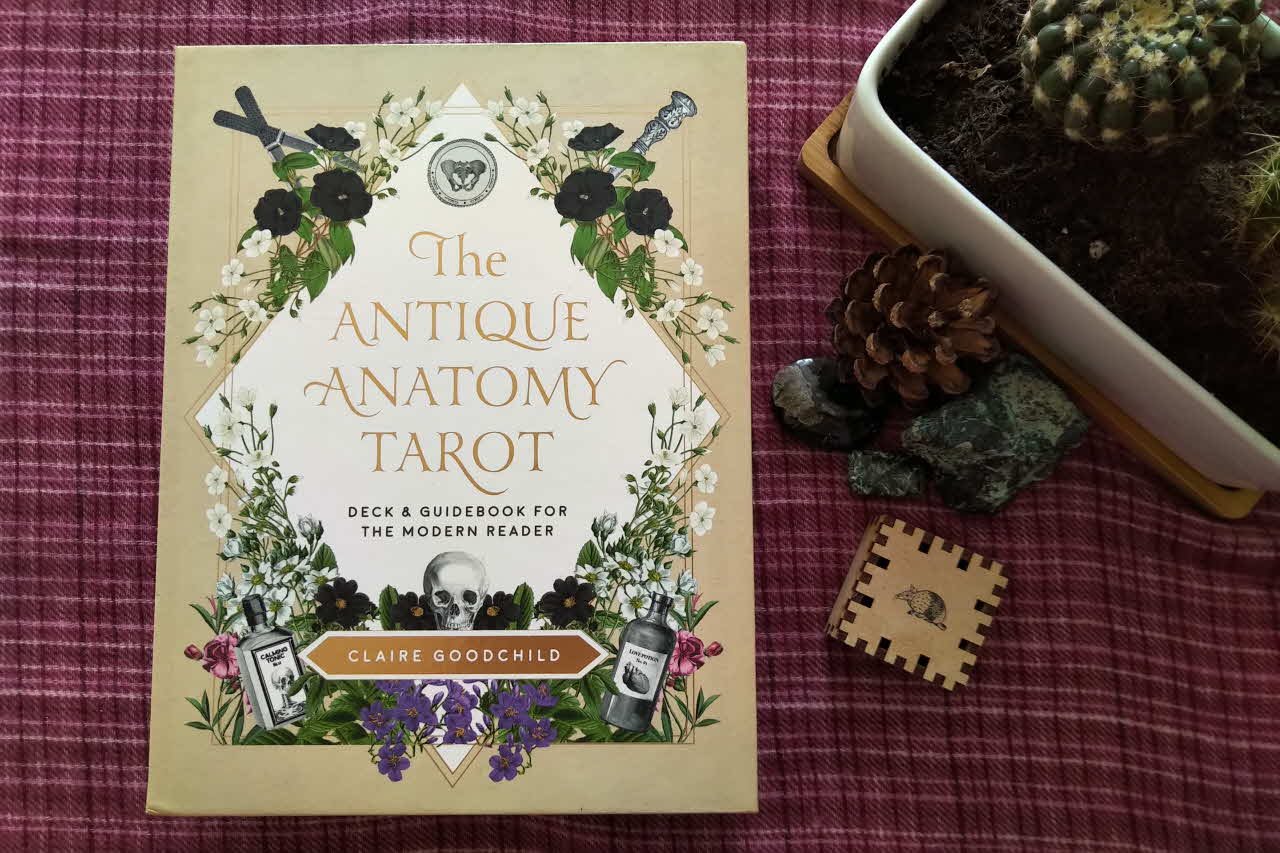Carnival at the End of the World
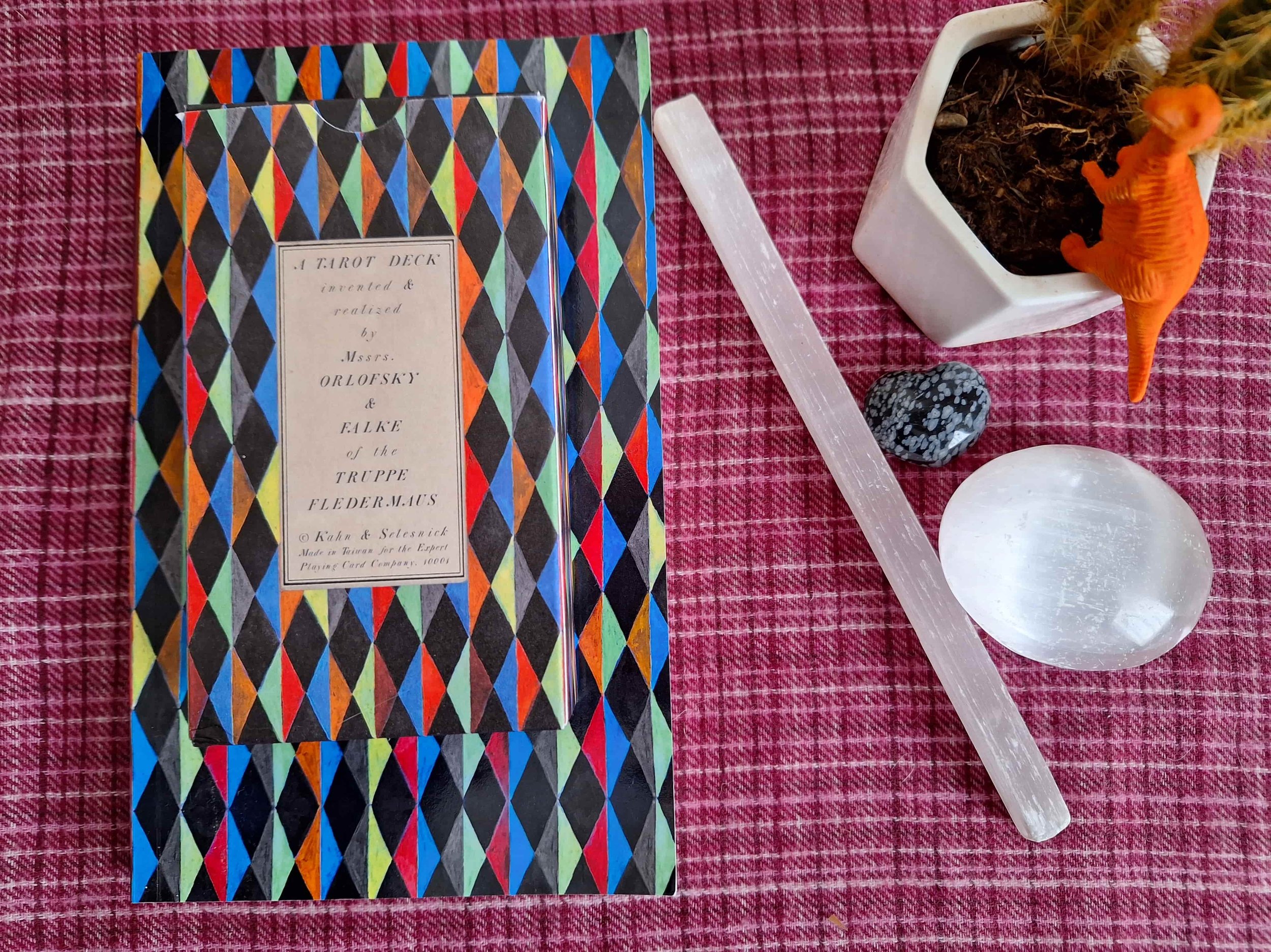
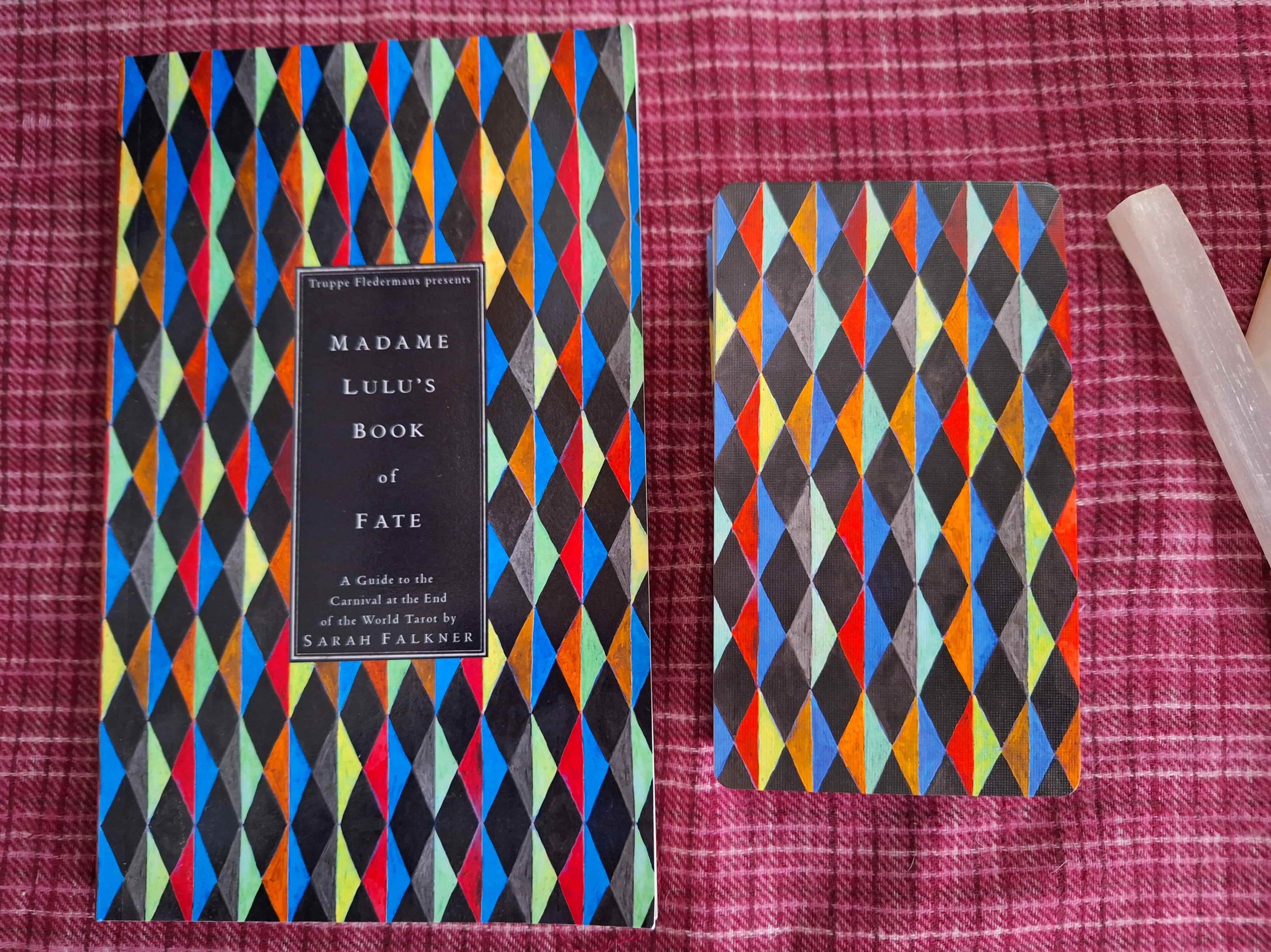
The Carnival at the End of The World is a unique deck. It’s not the cheapest tarot set available, but it’s strong enough in design and concept to warrant its self-published price tag. I had my eye on this deck for a considerable time before my eldest son bought it for me last year. Ashamedly, I’ve barely looked at it. In my defence, life has been exceptionally hectic and it has taken until recently to create enough personal space to find time to explore my ever-expanding tarot library. Some decks I want because I just like the artwork, others are desired to fulfil a specific purpose and I like the artwork. This set fell into the latter category, and I sensed that it would require intense and consistent effort on my part once I felt ready to engage with its contents.
The book and deck are separate, so there’s no box to keep them together. The cards come in a pretty flimsy tuck box, but I like that the design matches the pattern on the back of the cards. The cards are slightly larger than a standard deck and printed on what I think is good quality playing card cardstock. The book cover is laminated, and the inside pages are brown which makes it feel cheap. I’ve already spotted a few typos, repeated words, and missing spaces. However, from what I’ve seen so far, the text is nicely original in content and format.
First published in 2018, the deck was created by Nicholas Kahn and Richard Selesnick. They’ve collaborated as artists for decades, and this tarot deck was born from an earlier multimedia installation they created. The book is written by Sarah Falkner as Madam Lulu. The cards alone are $55, with the book and postage it costs around £65 if you’re in the UK, which isn’t all that bad. If you’re low on resources and can’t decide whether it’s worth the investment, I’d say it probably is, but only if you’re drawn to it and know you will use it heavily.
The original installation centred around a “fictitious cabaret troupe Truppe Fledermaus (Bat Troupe) – who travel the countryside staging absurd and inscrutable performances in abandoned landscapes for an audience of no one. The playful but dire message presented by the troupe is of impending ecological disaster, caused by rising waters and a warming planet, the immediate consequences of which include the extinction of the Bat, a shamanistic figure representing both nature and humanity.”[2]
The extra cards are characters from the cabaret troupe. In the guidebook, they are given space at the very beginning. I wanted to deal with them at the end so that I didn’t pull the focus away from the core part of the deck. There are also six of them, and rather than being just a couple of extras, they seem to form a very distinct grouping of their own. Once I began looking through the cards to find a few to focus on, I realised I needed to stay true to the format. So, I’ll be dealing with them first.
The creators call this group the insubordinate arcana. We are further informed the group refuse to be organised by hierarchy, and they can represent a person, entity, an aspect or process of the person having the reading, or an event. They appear to notify us of big changes and intense energies. The bottom-line advice for each card is to be disobedient in the face of pre-existing orders. In brief: The Tempest represents intense energy and advises on using it constructively. The Inferno represents power, The Deluge represents floods (emotion or something else) and evolutionary process, Doctor Falke represents a person or characteristics associated with philosophy, writing, and wisdom-seeking, Orlofsky appears to be a braver, more intense version of The Fool with an added twist, and Madame Lulu is truth, mastering the ability to get on with it, and finds the lesser of two evils. The book gives about a page on each card and I feel irked that I can’t do them justice in such a small space. They all appear to useful additions.
The major arcana are all named, and therefore easy to identify. Many are in keeping with traditional Rider-Waite symbolism with a healthy dose of Dadaism/Absurdism/Surrealism or however else you want to categorise the imagery. The Magician reminds me of many collages I’ve seen over the years. The swapping of the head for a mechanical object is a popular theme, and one I generally like. The High Priestess and The Empress both have antlers, which is interesting because of the deck I looked at yesterday (Le Tarot aux Ramures Étranges). It’s a little odd to have The Empress with her back to the reader and I’d find it hard to interpret this without thinking there’s a hidden message to turn away from those who expect or demand nurture. Or, maybe she’s on her way to do something important? The Lovers is another strange card; strange because they seem to be joined by a weird object. The interpretation in the book is good; especially the last bit “Traveler: what have you chosen & why, & how does it bring you to where & with whom you find yourself? Would you choose the same again, & what will you choose — and from what will you choose — next?” But, it was The Hermit card that was first to catch my eye when I first came across the deck. I’m tempted to take a closer look, but I really need to do a deep dive on The Devil and then I have an enormous stack of minors to get through. Actually, I’ll do The Hermit first because there’s not too much text.
The Hermit reminds me of someone else’s art and I can’t think who, and it’s now bugging me. It’s entirely possible I saw work relating to the artists’ installation being shared online back in 2014. Anyway, this card draws the ‘seeker’ aspect of the card into sharp focus. I like the lamp in its hand, and how large The Hermit appears to be compared to the mountains. The cyclops-like vision suggests a person who doesn’t miss much if it comes onto his or her radar. I find it interesting the figure is cloaked in red, usually a colour representing lifeforce and direct energy. The book’s description is quite lovely, if not a little sad at the same time. After reading the passage, I wanted to share it: “Traveler, when the path gets very narrow & dark you will find there is only room for one upon it: whether you must seek the Hermit or must be the Hermit, either path is one of Solitude in the pursuit of wisdom. What happens when you remove yourself from the company of others to rest your ears & mouth, & no longer hear the chatter of the crowd, the passing vehicles, the quotidian hullabaloo of commerce & community? In the silence & dark, your other senses grow sharper & your notice finally apprehends all that would be drowned out by harsh light & loud voices. The Pilgrim listens and watches & is rewarded with expanded vision: you carry a lamp to guide you, but its glow will become outshone by your own inner brilliance the longer you walk the narrow & dark path alone.”
As you can see, the style of writing is not straightforward, but the message hits the mark. I always like it when questions are given because I think it helps to direct any necessary soul-searching.
The Devil is shown as a man dressing up in a costume. He looks tribal and animalistic with his double-horned headpiece. In the book, it’s easier to see the horns have two sets of eyes — it’s two heads joined as one. We have symbolism in the form of goat, snake, hare, crow, and cat. I’ve chosen the Devil to share as he came up in a reading I did for myself (with The Lovers, for those interested). It was entirely appropriate once I read the description in the book. “Force divorced from understanding, sensation untethered from wisdom, consumption without satisfaction, power applied only for immediate gain, magic wielded in the service of pride, anger erupting without origin in righteous cause, willful ignorance, fuel burnt with no gauge on the tank: the Devil supervises the transformation of Earthly pleasures & abundance into torments & famines, & his military campaigns advance on every front. His empire floats on a molten sea that sparks & flames each time He feeds it another tribute, the prisoners of his Wars, conscripts pressganged into his service: the abusers & the enablers, the seducers & the lured, the deluders & the conned, the hucksters & the suckers, the blamers & the shamers, the stupid & the mean, the violent & the lazy. The greedy & heartless without hesitation do his bidding, thinking to shave off profits for their open coffers — but they can’t take it with them when they are cast into the fires themselves, & He laughs last at them. The Devil’s materiel is the Material, & so the wise Traveler is safe from his machinations, if having already been liberated from bondage to the dimension of physical manifestation: the Unseen has already revealed to you the remedies for the Devil’s plagues!” I like how this card makes it clear that you already know the answer and how to fix, sort, or alleviate. The card closest will likely back up exactly what you know.
The Tower is an interesting card because it appears to show many buildings joined together as a figure. The interpretation in the book distinguishes the effects of this card depending on the motivations of the person asking the question. The artwork for The Moon definitely borders on the absurd but there are a couple of traditional symbols in there too! The crayfish at the base of the woman, and her crescent moon tiara make her familiar.
The suits are heavily illustrated, and the court cards are Page, Knight, Queen and King. The two of wands is an interesting card with the two-headed man. The book tells us that the twos are about balance and binaries. The heads are looking in different directions, but they have only one set of legs. Here we have an indication that there are two ways to go and a decision needs to be acted upon. Wands represent fire, and as such, indicate action not thought. I like that the three of wands show someone already moving forward on a path. It’s nice to get a respite from the ‘waiting’ so often shown in the artwork of other decks. In the five of wands, we can see a man hopping above a fire, and I love the book’s description and how it tells us that “it is the hesitant & plodding whose toes will burn.” The eight of wands deserves a mention for using a pangolin in the artwork. Or at least I think it’s a pangolin. Although, it’s not generally an animal I’d associate with swiftness. . . The nine of wands is an uncomfortable-looking image, but the description in the book is reassuring. It talks about how we are almost there, and the cockerel surely symbolises that the long night has passed and dawn is now here. I have to mention that one of the obvious aspects of the Knight of Wands is that he’s too big for his horse. From this, I get that he has ambitions beyond his current standing. I find the Queen of Wands to be a curious image. Why is she dressed in a burka? Her stance is strong, and I like the bird perched on top of her wand. The guidebook says, “There is a type of focused power that burns so bright it must be covered & contained; when freed from devices of constraint & concealment, it pierces its target with a glance, & skillfully apprehends whatever is set in its sights. You will get what you want, come Hell or high water! Success in manifesting, attracting, & whatever you undertake — all will be uncovered & revealed to you.” The interpretation is a good one, but the burkha doesn’t work for me. I get that the focus is on the eyes and something needing to be covered but it seems a bit shallow. I’ll have to think more about this card.
The Swords are an excellent suit overall, although the ace of swords is a tad extreme with the disembodied head impaled by a sword. My go-to card of the three of swords is slightly tame in this deck. Well, apart from another disembodied head. It’s a symbol-heavy card because the head is in a box that has the legs of a chicken, and a cockerel-shaped weathervane is fixed to the roof of the box. Symbolically, we are being shown that despite feeling out of control, there will be a new day. Or maybe it’s a suggestion that no matter how disorientated you feel, the best thing to do is to keep moving. The guidebook says, “Piercing words, pain, & grief: all around you is strife, quarrel, & attack. The isolation, the loneliness, the trauma of being ganged-up upon. You feel you cannot endure it, but you join the ranks of the walking wounded & in abandoning the site of your sorrows are able to recover after you put some distance between you & the source of your injuries.” I do find it interesting the artists have isolated the mental effects of extreme emotion. After all, the swords are supposed to represent the stuff that goes on in the mind. The five of swords takes an unusual angle. It often represents a no-win situation, and here we have the suggestion of making allies from our enemies. I’m always intrigued by the artwork in the eight of swords because it generally represents a complex situation. A person is usually shown trapped but with an easy exit to escape. I love that the emphasis is placed on communication here because it is always at the root of the problem when this card appears. The ten of swords as a card that indicates loss and ruin minimises nothing and shows a character pierced by swords and arrows. The guidebook book emphasises that it is indeed a time of ruin, but then makes it clear the worst is now over and encourages acceptance so that we can feel the realisation that we have survived an ordeal. The giant ear in place of the head for the Page of Swords is an obvious reference to a few aspects of the card. The high level of communication, the gossip, the need to listen. The hand wielding a sword could also indicate a need to defend against attack. Listening is further emphasised by the little animals wearing headphones. Humpty Dumpty as the Knight of Swords is an odd choice. He could represent a person who is easy to defeat, or it could be a warning that communication is not what it seems. “When I use a word,’ Humpty Dumpty said in rather a scornful tone, ‘it means just what I choose it to mean — neither more nor less.’ " [3]. The guidebook gives a different story, but it’s a similar angle.
The pentacles begin on a sweet note with a mole breaking through the surface of a fertile ground. It’s my least favourite suit, and on the whole, I don’t have all that much to say about the cards. The designs are all nice enough and the interpretations in the book are more than adequate — the other suits are simply more intense. The three of pentacles makes good use of showing how rewards will come from one’s own body — the physical effort we put into our work. I like that the woman is covered in fruit and balances like a hammock between two trees. The five of pentacles is the one we don’t like to see in a reading because it indicates some type of poverty. The artwork is consistent with the rest of the deck in that it’s a little absurd and unusual. We don’t normally see a lemur riding the back of a man pretending to be an ox. Although, it could also be a buffalo. The guidebook says, “Lean times for the wanderers: the indigent share even meager supplies amongst themselves, though no benefactors are in sight to give further aid. There is no shelter but in the shadow of one another, there is no conveyance of transport but one’s own feet & the shoulders of allies. In a time of inadequate material resources, there may yet conversely be abundant affinity & companionship!” Interestingly, we could be represented by the lemur, the ox, or the rats on the ground. The nine of pentacles as an enormous watermelon isn’t all that out of place. This card commonly represents someone fruitful with many skills. The face of the watermelon could symbolise the body having its own ideas that appear somehow separate from the the conscious mind — and if you know, you know.
And finally, we have the cups. The two of cups is a fairly typical presentation of the card showing two people mirroring one another. The costumes are curious, though, and I have to wonder about the veil-like material covering both characters. This is probably the first time in my life I’ve been cringed out by the three of cups. Actually, it’s not, I didn’t like the Deviant Moon version either. In the Carnival at the End of the World, the person looks sticky, and sure enough, even the book mentions catching more flies with honey than vinegar. Nostalgia and memory ooze from the six of cups with many individual portraits forming the shape of a woman. I’m positively intrigued by the eight of cups because we seem to have an extra fish. We have eight cups, and the empty cup clearly shows its fish on the ground. But in the woolly creature’s right hand, we see a spare fish. From the guidebook: “You tried first this one, then this one, then that one, then that one, then another one, & another, & another, & another: it’s all so disappointing, you just want to quit, but then you would have to figure out what to do instead. You spent a lot of time tasting & testing that you feel something should have come of it all, but now it’s only time to go — there’s nothing here for you!” There is no mention in the guidebook nor sign in the artwork that refers to the emotional stuff usually occurring when this card appears in a reading. That might not be a bad thing, because it tends to indicate someone who is drained beyond and empty. The King of Cups is portrayed as an ox who radiates patience warmth, and calmness. The cup balancing on top of his head suggests he can be trusted with fragile objects. I’m unsure whether to say he has an extra pair of legs or normal hands. Whatever the answer, he’s a good king of cups. I get no sign of him dissociating from his emotion, but then he is stood on ice, so. . .
I never planned to use this deck regularly. I figured the heavy Dadaist vibe wouldn’t be appropriate for my daily grind. I do find it a bit pretentious on the whole, but I honestly expected that and it doesn’t interfere with my general feelings about the deck. The card designs reminded me of a period in my life when I spent an awful lot of time looking at art — an overall enjoyable, if not intense, period.
I think the quality could be a little better. I don’t begrudge the price tag, but I would’ve liked to see it in a box, with an insert, and with fewer mistakes in the book. I do need to mention that the cards look better than they’re showing on screen. I scanned them, as I always do, and after reducing the size and compressing the file it made small details almost invisible. I resized without compressing and they still don’t look much better. The colours are much richer than what is shown in this post. The cards are slightly too big for comfort, but they do shuffle easily and there is no sticking together. It’s hard to be too impersonal here because they’re going to be taking me on a deeply personal journey and I’d rather be writing about that than giving your reasons to buy or not buy the deck. It’s one for me, and I feel quite lucky to have it.
Website
[2] Installation blurb from 2014
[3] Lewis Carroll. Through the Looking Glass (1871)
Recent Posts
Archives
Categories
- Animal-centred
- Books
- Decks For Self-development
- Difficult Decks
- Expensive Decks
- Lenormand Decks
- Oracle Cards
- Oracle Cards For Beginners
- Out-of-print
- Personal Favourites
- Published 2000s
- Published 2010s
- Published 2020s
- Tarot
- Tarot & Oracle Sets
- Tarot Cards For Beginners
- Under £15
- Under £20
- Under £30
- Under £40
- Witchy Decks
- Woman-centred
